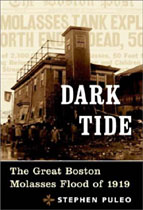Slower Than Cold Molasses

While I haven’t talked about it much in my journal, one of my hobbies is Boston’s topographical and architectural history. One of the many items of interest in Boston’s history that few people know much about is the great molasses flood of 1919. Sure, a few people have heard about it, and there’s the persistent urban legend that you can still smell molasses in the North End on a hot summer day. But there was never any memorial or other notice that the event had happened. It wasn’t until the late 1990s that a single small plaque was put on a public wall by the Bostonian Society to commemorate the event and indicate the place where it happened; but good luck finding it!
Even those few who have heard about it have little understanding of what really happened, which is odd, given its remarkable nature and the facts that (1) it was an immense industrial disaster that killed 21 people and injured 150 and severed the important elevated rail line between South Station and North Station; and (2) it spurred one of the largest and most influential civil trials in American history to that point. To this day people still look up and think the molasses flowed downhill from a storage tank at the top of Copp’s Hill, but in fact the tank was at the foot of the hill, at water level, right next to wharf where the molasses was offloaded from steamers from the Caribbean. Still, the fifty-foot tank itself was nearly as tall as Copp’s Hill. At the time it disintegrated as a result of negligent construction, the tank released 26 million pounds-13,000 tons-of molasses: enough molasses to fill more than 350 modern 18-wheel tanker trucks, sending a 15-foot high wave of heavy molasses and flying steel plates in all directions in a crowded residential and commercial neighborhood.
Anyway, all the misinformation and lack of knowledge can be set right if people read a new book that just came out. “Dark Tide: The Great Boston Molasses Flood of 1919” is incredibly the very first book to examine this event. The book sets the tragedy in historical perspective, and contains the personal accounts of many of the people who were present when the tank collapsed. The author, Stephen Puleo, drew most of his portrayals directly from the more than 25,000 pages of incredibly detailed testimony that came from the court case that (pun intended) ensued. It is, needless to say, an excellent and long-overdue treatment of a meaningful episode in the city’s history.
I first learned about the book about two years before its publication, at a lengthy and detailed presentation that Puleo did at the Medford Public Library, if I recall correctly. I also read his article in American History magazine, and additional articles in Yankee and Smithsonian. It’s an interesting topic, and a fascinating part of Boston’s heritage that has long deserved a conscientious telling.
And another historical book review will be coming shortly, this time with an even more personal note…